I have really wanted a semi or full custom pistol for a while. I wanted a pistol that would be useful in competition but also practical. I have always admired the craftsmanship of custom 1911s but wanted a 9mm for competition because of the capacity and cheaper cost of ammo. When I saw the sig X5 series they really caught my eye.
The flagship model is the Sig X5 L1. On the sig sauer website it is just listed as the P226 Sig X5. Sig pistols have always had a reputation for accuracy and the X5 series is supposed to improve on this with the hand fitted barrels. The X5 pistols ship with test targets that show 5 shots inside of a 2 inch circle. There is no accuracy guarantee on the sig sauer website but there are many test targets available for viewing on the internet and they are all inside the 2” circle, many of them well under 2”.
As I did more research on the X5 I found that it is a little too long and too heavy for some pistol competitions like IDPA. A gunsmith can modify the gun by shortening and lightening it. I didn’t want to have to do this. I also read of several complaints of extraction problems with the 9mm version. The extraction problems seem to be contained to the 9mm model and do not affect the .40. I also read that sig has made a change to the extractor so the problem may have been solved. Even with the possible extractor fix I didn’t want to risk having an issue with a gun this expensive and it is not legal in all of the shooting sports.
While looking further on the sig sauer website I found the P226 X Five Short and Smart. This is one of the mastershop pistols. It is a modified X5. The short and smart uses a standard P226 length barrel and slide. It is also one of only two X5 models to use the standard external short extractor that is well proven in sig pistols.
The short and smart is Legal in IDPA ESP, IPSC standard, USPSA Limited, 3 Gun, and steel challenge limited. The pistol isn’t exactly ideal in most of these divisions but there is no reason it will not work very well. It is slightly handicapped because most purpose built guns for the divisions listed above will have 5” barrels compared to the short and smart’s 4.4” barrel. The pistol also only comes in 9mm which will make it shoot minor power factor. A complaint with the standard X5 which is available in .40 is that it has a lower capacity than a comparable sti or similar pistol. The short and smart comes with 19 round magazines. Aftermarket 18 round mecgar magazines are readily available and can be upgraded to 20 rounds with aftermarket baseplates. TRT tactical is one company I found that sales these baseplates. Their baseplates are also made to fit the mag well that comes with the short and smart. For IDPA ESP the maximum pistol weight is 43 ounces. Sig advertises the weight for the pistol at 43.5. I weighed mine and got an approximate weight of 40 ounces. If the pistol did happen to be slightly over the magwell could be removed to make the weight limit.
Although the short and smart isn’t purpose built for any one competitive shooting division it does make up for it in other areas. One area where the short and smart appealed to me is that it has a similar model in the standard sig line, the P226 sao. I like this because I can train and shoot competitions with the short and smart and then carry a pistol that is exactly the same size and uses the same style trigger and controls. The short and smart has an adjustable trigger while the P226 sao does not. The safety, grip, and slide release are all the same as far as use and location. The P226 sao is lighter and more suitable for carry with its lighter aluminum frame. The short and smart is heavier than many other comparable competition pistols because of its steel frame (pistol weight listed as 43.5oz). This may not appeal to everybody but it makes the 9mm very soft shooting. Another aspect of the short and smart that sets it apart from the other x5 models is that is uses fixed sights. The short and smart and the X5 tactical are the only x5 pistols that use fixed sights. While adjustable sights are the most common type in competition I prefer fixed sights. It takes a little more work to find the correct sight heights but I like the lower profile of fixed sights. Ultimately the short and smart isn’t ideal for any one use but it can do just about anything very well. Women don’t wear heels because they are the most comfortable or practical, they are sexy, and this pistol is sexy.
A nice feature of the X5 pistols is that they come with a test target. Most X5 targets are shot at 25m but the Short and Smart comes with one shot at 15m. Sig tests their “duty” guns at 15 and their “sport” guns at 25. The 5 shot group measured 1.568 center to center.
The fit and finish on the gun is very good. I have seen other all stainless sig pistols and the slide and frame have a slightly different finish. The bead blast or whatever they use to finish the stainless steel has a slightly different texture. I believe this is because on other all stainless sig guns the frame is made in germany and the slide in the US. On the short and smart the frame and slide have the same finish. I was able to identify some light tooling marks inside the frame at the bottom of the dust cover. I also found a small scratch inside the front of the frame where the barrel sits. I havent been able to see any other tooling marks. There may be some hidden under the controls or inside the action but these would only be visible if the pistol was completely stripped. The frame, slide, and barrel are marked DE which shows they were made in Germany. A nice feature the pistol has that doesn’t come on standard sig pistols is that the hammer is slightly rounded at the top. The part of the frame that first contacts the hammer is also rounded and polished. When the pistol is hand cycled it is noticeably smoother because the slide does not have to force its way over the edge at the top of the hammer. The pistol comes with a number 7 front and rear sight. Standard P226 pistols come with a number 8 front and rear. The number 7 combo hit POI/POA for me. Most sigs hit low because they use a goofy “combat” style sight picture where the dot is supposed to cover the target. One thing that sets the X5 series apart from the standard P226 line is that they use a minimum amount of mim parts. Although mim parts can work very well I much prefer barstock parts on a hard use gun at least in the extractor, hammer, and sear.
Another difference I noticed is that the pistol use a combat style takedown lever. This part doesn’t function any differently than other takedown levers but is machined out of better materials. I was surprised to find that the hammer strut and trigger bar had been highly polished at their contact points. I was skeptical how much hand fitting would actual be done on the pistol but these parts clearly showed it. The hammer, sear, safety lever, safety lock lever, and ejector also show that they have been fitted and polished. After taking the pistol apart the sear and hammer are not mated perfectly. The sear only shows contact on about half of its face. I have read from a reliable source that this is normal in the X5 series. Not normal in that it is good and shows nice fitting, but that it is standard for the sear and hammer to be fitted to this level. A nice feature of the X5 line that is also included in the P226 SAO is the undercut frame. At the top of the grip where it comes together with the rear of the trigger guard it is relieved. For me this allows for a better grip on the gun. One noticeable difference on the pistol from the one pictured on the sig website is that it uses a spiral pin for the firing pin positioning pin. The photo shows a solid pin. The spiral pins are easier to remove and replace. The solid pins had a reputation for being very stubborn.
I expected the slide to frame fit to be very tight. When I first picked up the pistol the lateral fit of the frame to slide was the same as other any other good sig pistol. The vertical fit is definitely different. I can not feel any vertical movement between the slide and frame, it is very tight. Another area that was noticeably tighter was the locking block. In every other sig I have seen or owned when the slide is off the frame you can push down on the locking block and there will be a slight bit of movement. There is no movement in the locking block on the short and smart. I have no idea what impact this has on the performance of the pistol but it is fit tighter.
After shooting the pistol I completely stripped the frame. I wiped down all of the parts and put slide glide grease on them before putting them back in the pistol. After the pistol was back together I noticed that the trigger felt sticky. It got to the point that if I held the trigger to the rear and cycled the slide the trigger would stay to the rear and not return forward. I figured that the grease was too sticky so I stripped the pistol again. I wiped off the grease and used oil. The trigger was a little better but still felt sticky. The only other part that has contact during the trigger pull was the trigger pivot pin. I took it out and oiled it. Trigger was back to normal. Apparently the pistol is tighter that I had first assumed.
One aspect of the SAO X5 series that really sets them apart from other sigs in function and price is the adjustable trigger. You can adjust over travel, pre travel, pull weight, and trigger distance. Although I know I will eventually adjust the trigger just because I can the trigger is incredible out of the box. It has about a 1/16” take up followed by a clean break with no perceptible over travel. There might be 1/64” of over travel at the end but it is hard to perceive. There needs to be a small amount of over travel to ensure reliable function. The trigger breaks at 3lbs. During the takeup there is a small hitch that can be felt as the firing pin block is pushed out of the way. The reset is very short, comparable to the distance on a sig with the short reset trigger.
The trigger rides on a bar in the frame. There is a screw on the trigger that can loosened and then the trigger is pushed forward or back to adjust the reach. The overtravel is a simple screw that uses the bottom of the locking block as a stop. The screw can be screwed in or out to change how soon it hit’s the locking block. The overtravel stop works the same way it does on a 1911 but instead of using the frame as the stop the sig uses the locking block and the screw is oriented vertically. The pull weight system is a little more complex. I cant tell exactly how it works but it appears to possibly work like an adjustable spring that changes how much pressure is pre placed on the trigger. More pressure would increase trigger pull weight. The pre travel adjustment is accessible when the pistol is field stripped. What is interesting is that all of the adjustments in the system are contained within the trigger area. They do not extend into or change the sear and hammer operation. The pistol uses a different safety lever in the fire control group. The leg on the safety lever that is engaged by the trigger bar is longer. My educated guess is that this provides greater leverage which is how the pistol is able to get the trigger pull weight into the low 2lb range.
Trigger pull weight:
Clockwise, increased pull
Counter Clockwise, reduced pull
Overtravel Stop:
Clockwise, reduced overtravel
Counter Clockwise, increased overtravel
Pre Travel:
Clockwise, reduced pre-travel
Counter Clockwise, increased pre travel
The grips on the pistol are fit very well. At first I thought they may have used a different method to attach them to the pistol because I could not see a seam where the grips meet. It is there, the grips just match up perfectly. I prefer g10 over wood grips and will eventually change them but they are functional and feel nice. The grip is more round and fatter than a glock or M&P. It feels somewhat similar to a M&P with a large grip insert. The grip is a result of the way sigs are constructed. They have a metal frame and then the grips go on top of this so they cant be as thin as polymer frame pistol. The grips can be used with the mag well attached or left off the pistol. The magwell is not a huge, squirrel family living inside, type of magwell but is functional and I prefer the lower profile. The magwell slides onto rails that are part of the frame. A small plate goes over the rear of the magwell and keeps it from moving. The magwell can also be removed and the pistol looks like a standard P226. The grips cover the rails and are flush with the bottom of the frame when the magwell is removed. It is a very nice integral and convertible design.
The safety is interesting. I had read some complaints about the safeties on sao sigs. Either they were too heavy, too soft, or were mushy and with a little pressure the safety would be disengaged but would still appear to be in the on position. Either I got lucky or they have fixed the problems because mine is good. It snaps on and off with a distinct feel. The ergonomics of the safety work well. I have average sized hands. I am able to use a normal thumbs up type grip where I ride the safety with my thumb after pushing it down. This does not interfere with the slide release. At the same time I am still able to use the slide release after a reload without shifting my grip. For me the front of thumb safety ends at the joint on my thumb. I ride the safety with my thumb straight but when I bend it down I can push the slide release. When my thumb is straight I have a normal thumbs forward grip and it doesn’t interfere with the slide release. If you have stubby fingers you may not be able to do this. The safety can be engaged with the hammer down or cocked. The slide cannot be worked with the safety on like a 1911.
The pistol comes with a very long competition style mag release. It doesn’t get in the way when I grip or operate the gun but standard size sig mag releases work fine for me.
The frame does not have a rail. The dust guard has the same dimensions as a standard P226 but without the rail slots cut in. The only major difference is the trigger guard. I measured a standard P226 and the trigger guard is .461 wide. The trigger guard on the short and smart is .540 wide. This means that holsters that index or fit off the trigger guard wont work. A P226 serpa holster wont fit the short and smart. The slide width is the same width as a P226.
The pistol comes with 2 19 round Mec Gar magazines. US made sigs now ship with checkmate magazines. The finish on the newer checkmate magazines is not as nice as the mec gar mags. Because the magwell on the pistol is smaller you have to use sig or aftermarket baseplates made to fit the magwell. Aftermarket 18 or 20 round mecgar magazines wont work unless you take a dremel to the base plate. The factory 15 round sig magazines will work but the base of the magazine will be inside the magwell after it is seated. The magwell can be removed and then any p226 magazine would work. Aftermarket 18 round mec gar magazines with plus 2 base plates made for the sig magwell are cheaper than factory sig mags and hold 1 extra round.
A little rant to follow. When I hand cycled the pistol very slowly I noticed it wouldn’t go fully into battery. There is nothing wrong with this and can show that the pistol is tightly fitted. During normal operation the slide goes fully forward. I field stripped the pistol and noticed that the recoil spring had white paint on it. My other P226 pistols have orange paint on them. When I compared the springs side by side the one with the white paint was noticeably shorter. Sig P229 pistols come with recoil springs with white paint. This is a shorter pistol and uses a shorter spring. The spring that came in the pistol has 12 coils and my other 226 springs have 15. The regular sized X5 pistols use a unique recoil spring. This pistol is essentially a standard sized P226 that has a steel frame and adjustable trigger. There are some other minor differences but nothing that should affect the recoil spring. I called Sig and the first call went silent and the representative never came back on. I called a second time and this representative told me the short and smart was a very different pistol and the spring was correct. I am not a sig expert but I do know a little bit about the pistol. Next I called the law enforcement line and was transferred to somebody that went to voicemail. I called one last time and this representative told me that the paint didn’t mean anything and that he would need pictures to determine if there was a problem. With a little prodding he took the serial number and told me that the short and smart does indeed use a standard P226 9mm spring. After all that I am able to say that whatever spring came in the short and smart does not appear to be a standard P226 spring and the spring out of my other P226 works fine. After replacing the recoil spring with an orange marked P226 spring the slide goes completely forward by itself but there is some resistance as the pistol goes fully into battery. To me this is an indication that the pistol is locking up very tight.
So is the pistol worth it? I worked up some comparisons off the sig website from a sig P226 model and msrp prices and what the upgrades cost.
Sig P226 no night sights msrp: 1015
Adjustable trigger/SAO: 750
Steel frame: 280
Wood Grips: 75
Magwell: 70
Total: 2190
The short and smart has an msrp of 2600. After the price of the upgrades you are paying an additional $410 for a hand made german pistol with a minimal amount of mim parts. This breakdown is just an estimate but willl give an idea of how the pistol is priced and what the upgrades cost on different models. One thing that the short and smart doesn’t have when compared to the other X5 pistols is a larger bull barrel. It is unfortunate that this barrel is not used on the short and smart as the superb accuracy of the X5 L1 is one of its main selling points.
I took the pistol out and 350 rounds through it. My very first shot was at 20 yards and it was dead center on a steel target. I knew things were going to be good. A 7 yards I did a few bill drills. With a strong grip on the pistol I was able to just pull the trigger. I watched the sights lift and come back down and they never came off the target. The weight of the pistol soaks up the recoil. I was getting splits at .18 and .19 which is fast for me. At 20 yards I shot left hand only and was easily getting hits. I have not been able to do this in the past with so little effort. Unfortunately I had one malfunction. An american eagle round failed to extract. The brass was left in the chamber and the slide had cycled. I cleared the malfunction and did not have any other problems. It could have been the pistol breaking in or the pistol being under sprung with the factory white painted recoil spring. I will see if the problem continues. I shot american eagle, hornady training, cci lawman, and Winchester ranger +P. All of it worked great with the exception noted above. Overall the pistol is incredible to shoot. It is like shooting a high capacity 9mm 1911 with less recoil. The saying goes that money can’t buy skill, but a light trigger sure comes close.
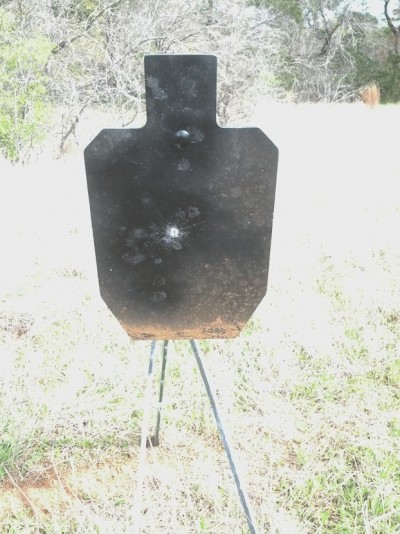
First shot at 20 yards.
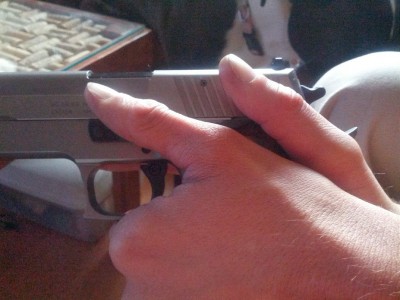
Thumbs up grip on the pistol. Right thumb is on top of the safety. Slide release lever visible between two thumbs. Neither of my hands are touching the slide release lever.
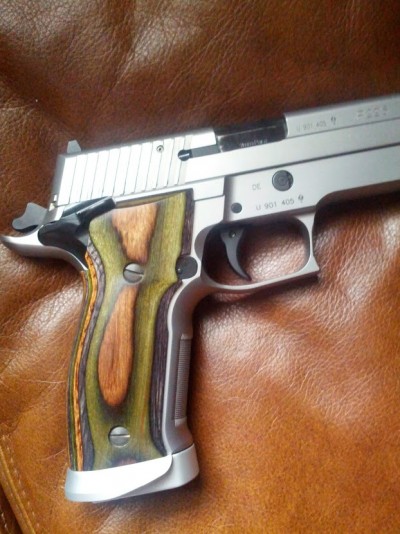
Short Extractor and combat style takedown lever visible.

Allen head screw in trigger is used to adjust trigger position. Also note the undercut frame at the back of the trigger guard.
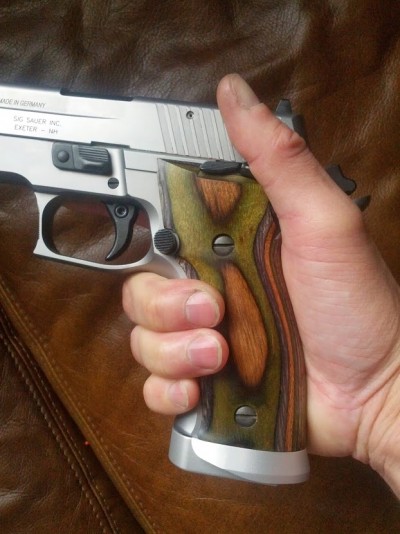
Thumbs high grip with thumb on safety.
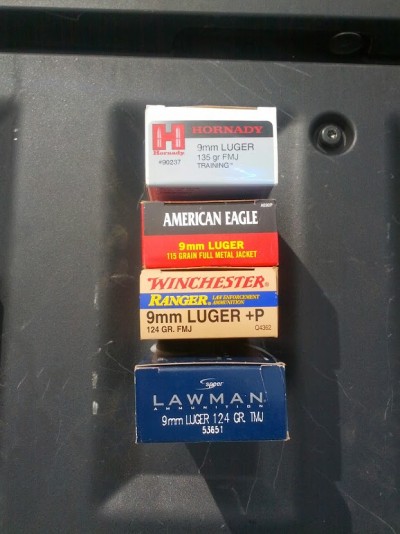
Ammo used during first range session.
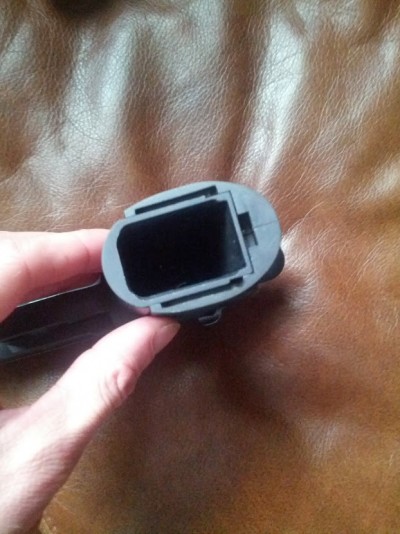
A sig P226 SAO with no magwell.

Top of hammer rounded. Stock number 7 rear sight.

Trigger removed from gun.

Light machining marks inside of dust cover.
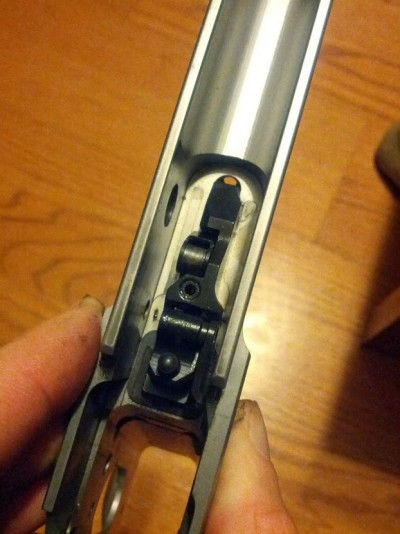
Another shot of the trigger. The vertical projection at the rear of the trigger is the over travel stop. The allen head that is visible is used to adjust pre travel.

The rounded wheel looking item is used to adjust the trigger weight. The trigger weight screw is at the very front of the trigger assembly. As it is screwed in it pushes the wheel further forward which creates more tension resulting in a higher trigger pull weight.
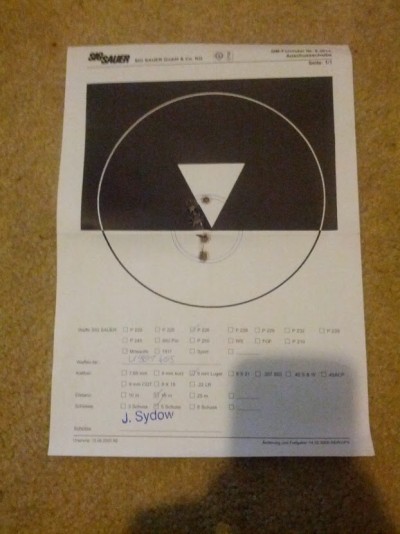
Factory test target. Shot at 15m.

Holes in the frame are used to access pull weight and overtravel adjustment.
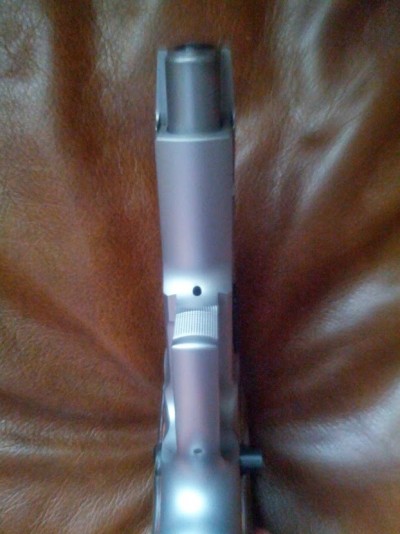
View of safety mechanism with grip panels removed.

Thumb pushing down on slide release lever.

Polished trigger bar and hammer strut.

Very nice method of attaching the mag well.

Slide removed and fire control group visible. Top of safety lock lever is rounded and polished.

Hammer and sear. Note uneven wear on the edge of the sear face.
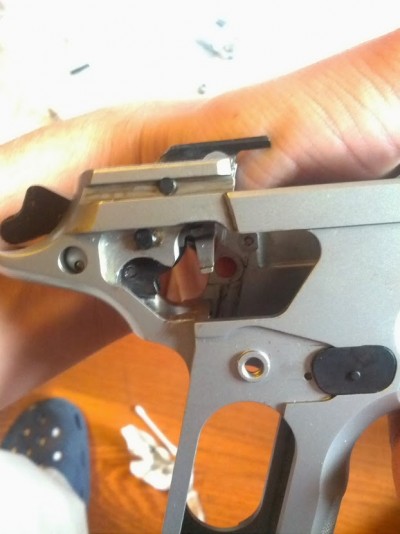
Longer arm of safety lever visible. Exquisite crocs footwear also visible.


Comments
Thanks for your great review. I live in Dallas and am a Sig fan. In fact I have a P226 X5 9mm. Is there a really big difference between what I have and the Short &Smart? I just might need one. Do you have a recommendation for a source where I can buy a P226 X5 Short & Smart? Thank you.
There are a few small differences. The biggest is barrel/muzzle length. The barrel and muzzle are about .6 inch shorter. The short and smart has roughly the same dimensions as a standard P226. They both have the adjustable trigger. The other difference is that the standard x5 uses a thicker barrel that is supposed to have better accuracy. The short and smart has a standard P226 barrel. If they fit it better I dont know. They are going to be harder and harder to find. I believe sig has stopped production of the short and smart and x5 and now only produce their new X5 line which falls under the “Xseries”. I believe the custom shop in Germany has closed and all of the XSeries are now produced in the U.S. This is from what I have read on various forums so it may not be accurate. Buds gun shop carried them for a while and top gun supply is also a big sig seller that may be able to get one.
Thank you. I got one on Gun Broker. Not cheap but picking it up tomorrow.
What do you think…I am a newer shooter trying to find a gun I really like. The Sigs I have tried I like. Yes as a girly girl they have to be smart looking. Would this gun work well for me? I’m very slim, I don’t like recoil and the gun must have an easy trigger. Price is not a concern. My biggest concern is aiming on the target and being able to fire easily. Your thoughts please.
It is a great gun but I would highly suggest you at least hold it first. Sig pistols can have fairly large grips and may not be ideal for your hands. As the short and smart can be hard to find I would also suggest the newly released Sig legion P226 sao.